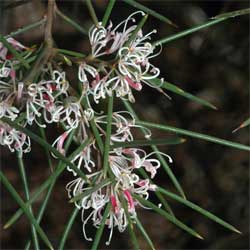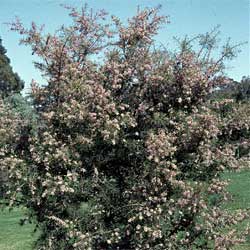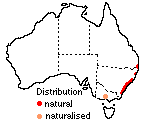Hakea sericea
 |
 |
Silky Hakea
Hakea sericea Schrad. & J.C.Wendl.
Silky Hakea (Hakea sericea) is a large shrub of New South Wales, Victoria and Tasmania, which is noticeable in winter when full of flowers. The common name refers to silky hairs on the tip growth, and Needle Bush, the general name for Hakeas with cylindrical sharp leaves, is more descriptive.
 The leaves are rigid and 6 cm long, and a jab from one of their pungent points
is to be avoided. Unless wanted for a deterrent barrier, plants should be grown
where they will not be brushed against. A strong, trimmed hedge could be made,
or in a small garden a good place for it would be back against a fence.
The leaves are rigid and 6 cm long, and a jab from one of their pungent points
is to be avoided. Unless wanted for a deterrent barrier, plants should be grown
where they will not be brushed against. A strong, trimmed hedge could be made,
or in a small garden a good place for it would be back against a fence.
Another answer is to grow the plant on a clear trunk with the spiny crown well out of the way, either spreading or lightly trimmed. This makes an unusual 7 m tree, decorated with woody fruits at all levels as they remain in place on the plant.
Allowing for its sharp points, Silky Hakea has many good features and can be a useful shrub, with flowers and foliage both interesting. In light, watered soil it grows at least 5 m in seven years, with stiff growth, the heavy branches arching at the tips. Examples can be seen in the Australian National Botanic Gardens, smothered with foliage and deceivingly lush from a distance, even feathery, as the leaves have no gloss. The effect is not unlike some conifers.
Very restricted watering or heavy soil produces a plant on a smaller scale, with smaller leaves and fruit but still tough and healthy; it has good drought resistance.
In the home garden, sparse wood can generally be pruned to make it bushy, but pruning has been kept to a minimum in the Botanic Gardens so that the plant's natural response to varying conditions can be observed.
A freely growing shrub has yellow-green tints from the tip growth in summer, turning bronze in autumn and then purple, and this colour can spread over the plant by mid-winter if it is in a sunny position. The species is exceptionally healthy in Canberra's cold winter climate.
This is one of several hakeas good for winter flowers in the Canberra region. The season is between May and October, and the plant is at its best in July and August. There is a scent of honey or almonds from the flowers.
The 'flowers' (in fact 'inflorescences') are the only delicate part of the species and are like dainty pale cream curls close on the branches towards the tips. They are composed of one to several narrow curved flowers on short stems in the wide angles of the leaves. A less common form has beautiful deep rosey buds opening paler pink.
The curious knobbly fruits are around 5 cm long, with a double-pointed 'beak', hard and woody, with light scaly patches while young. They accumulate for years and open only when the plant dies or is burnt. To obtain seed, the fruits are cut off with secateurs and brought indoors where they open in a few days, each fruit holding two large winged seeds. These are very easy to handle, germinate readily and are the best means of propagation.
Luxuriant, heavy growth full of fruits can make upright specimens top-heavy, especially in light soils during stormy, wet spells.
Hakea sericea is one of the species of hakea that has proved to be invasive in some regions outside its natural range. In South Africa and New Zealand H. sericea has become a problem weed, with seed being released prolifically after fires. Biological control, by means of foraging insects is proving successful in some cases. Other hakea species that have been identified as weed species are H.laurina, H. drupacea and H. prostrata. Care should be observed in planting any hakea species and it is recommended that hakeas should not be planted in areas that are close to natural bush.
Text by ANBG staff (1974)
Name meaning: Hakea sericeaHakea - after Baron von Hake, patron of botany in the 18th century; sericea - silky, alluding to tiny hairs on young growth |
![An Australian Government Initiative [logo]](/images/austgovt_brown_90px.gif)

